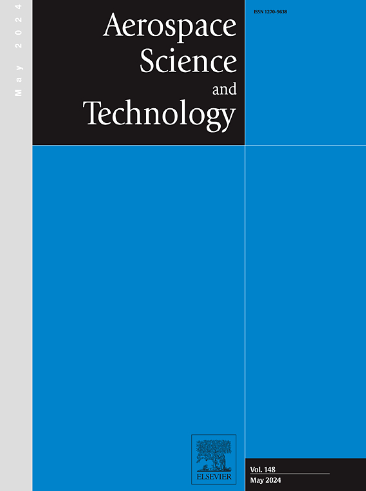通过人工智能验证提高连接到压电贴片的三向 FG 纳米板的效率和能量容量
IF 5
1区 工程技术
Q1 ENGINEERING, AEROSPACE
引用次数: 0
摘要
提高复合纳米机电系统(NEMS)的效率和能量容量在工程行业具有重要意义,因为它在提高航空航天结构和系统的性能、可靠性和安全性方面发挥着关键作用。其中一个关键应用领域是开发先进的传感器和致动器。针对这一问题,目前的研究工作介绍了如何利用三向功能分级层和压电贴片层提高夹层纳米板的效率和能量容量。为捕捉尺寸效应,提出了具有两个尺寸相关因子的非局部应变-应力梯度理论。横向剪切变形因子在预测各种结构的机械性能方面具有重要作用。因此,在当前工作中,研究了一种新的四变量精炼准三维对数剪切变形理论。同时,针对压电贴片与复合结构的耦合,提出了相容性条件。为获得 NEMS 的耦合控制方程,提出了具有三个因子的汉密尔顿原理。为了求解当前电气系统的偏微分方程,介绍了一种分析求解程序。此外,为了更好地了解当前电气系统的基频,还介绍了 COMSOL 三物理仿真。为了验证结果,介绍了一种通过数学和 COMSOL 多物理场仿真数据集的人工智能工具,以较低的计算成本验证其他输入数据的结果。最后,详细讨论了压电贴片的几何形状、FG 功率指数、长度比例因子、非局部参数和压电贴片位置等各种因素对相位速度的影响。当前工作的重要成果之一是,设计人员在建立 NEMS 模型时应注意施加电压、压电贴片的位置和几何形状。本文章由计算机程序翻译,如有差异,请以英文原文为准。
Enhancing the efficiency and energy capacity of the tri-directional FG nanoplate attached to the piezoelectric patch validated by artificial intelligence
Enhancing the efficiency and energy capacity in composite nanoelectromechanical systems (NEMS) holds significant importance in the engineering industry due to its critical role in enhancing the performance, reliability, and safety of aerospace structures and systems. One key area of application is in the development of advanced sensors and actuators. Regarding this issue, in the current work, enhancing the efficiency and energy capacity in the sandwich nanoplate with a tri-directional functionally graded layer and a piezoelectric patch layer is presented. For capturing the size effects, nonlocal strain-stress gradient theory with two size-dependent factors has been presented. The transverse shear deformation factor has an important role in the prediction of the mechanical performance of various structures. So, in the current work, a new four-variable refined quasi-3D logarithmic shear deformation theory has been investigated. Also, for coupling the piezoelectric patch and composite structure, compatibility conditions have been presented. Hamilton's principle with three factors has been presented for obtaining the coupled governing equations of the NEMS. For solving the current electrical system's partial differential equations, an analytical solution procedure has been presented. Also, to have a better understanding of the current electrical system's fundamental frequency, COMSOL tri-physics simulation has been presented. For verification of the results, one of the tools of artificial intelligence via the datasets of the mathematics and COMSOL multi-physics simulations is presented to verify the results for other input data with low computational cost. Finally, the effects of various factors such as the geometry of the piezoelectric patch, FG power index, length scale factor, nonlocal parameter, and location of the piezoelectric patch on the phase velocity have been discussed in detail. One of the important outcomes of the current work is that designers for modeling the NEMS should pay attention to the applied voltage, location, and geometry of the piezoelectric patch.
求助全文
通过发布文献求助,成功后即可免费获取论文全文。
去求助
来源期刊

Aerospace Science and Technology
工程技术-工程:宇航
CiteScore
10.30
自引率
28.60%
发文量
654
审稿时长
54 days
期刊介绍:
Aerospace Science and Technology publishes articles of outstanding scientific quality. Each article is reviewed by two referees. The journal welcomes papers from a wide range of countries. This journal publishes original papers, review articles and short communications related to all fields of aerospace research, fundamental and applied, potential applications of which are clearly related to:
• The design and the manufacture of aircraft, helicopters, missiles, launchers and satellites
• The control of their environment
• The study of various systems they are involved in, as supports or as targets.
Authors are invited to submit papers on new advances in the following topics to aerospace applications:
• Fluid dynamics
• Energetics and propulsion
• Materials and structures
• Flight mechanics
• Navigation, guidance and control
• Acoustics
• Optics
• Electromagnetism and radar
• Signal and image processing
• Information processing
• Data fusion
• Decision aid
• Human behaviour
• Robotics and intelligent systems
• Complex system engineering.
Etc.
 求助内容:
求助内容: 应助结果提醒方式:
应助结果提醒方式:


